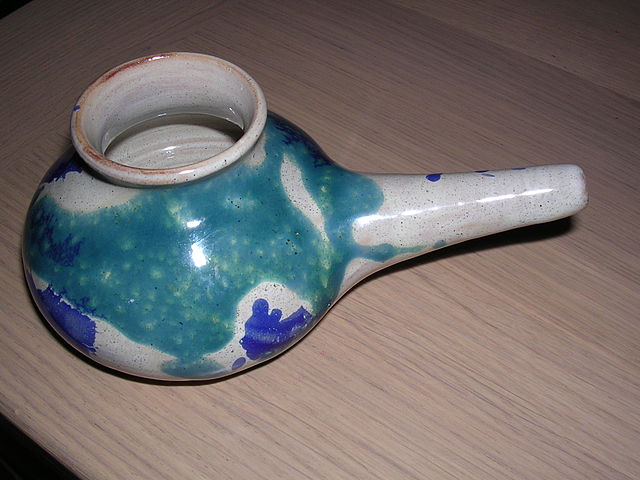SP asks: "I would like to know if nasal irrigation is considered new age. I was unable to find much on this, but I did read somewhere that in ancient times a certain people thought nasal irrigation could achieve enlightenment. I believe I suffer from chronic sinus infections, and nasal irrigation is only one recommendation to help ease and relieve the symptoms. I will be seeing my family doctor if I don’t feel better soon, but I would appreciate any information you have on this."
Nasal irrigation, or neti (which means nasal cleansing), began as an ayurvedic medicine technique in ancient India and is considered to be an important part of Shatkarma, which is the yogic system of body cleansing. Practitioners claim nasal cleansing has profound effects on the body and mind and that it can bestow a kind of divine vision.
According to this article appearing in Yoga Magazine, Swami Niranjan is quoted: "Neti provides a state of mental clarity which is useful for the higher practices of yoga. It is not simply the act of pouring water through one nostril and making it come out through the other. It is not only a practice of putting a catheter through one nostril and bringing it out through the mouth. Rather, the physical practice of neti gives birth to an internal state of neti which is the flow of prana shakti in the three channels of ida, pingala arid sushumna. Once the flow in Ida and pingala is balanced, then the harmony of their two flows will accentuate the flow of sushumna. The awakening of sushumna will, in turn, be responsible for the development of higher mental faculties, leading towards the nature of genius, intuition and creativity.
"The term 'divya drishti' means 'divine vision' and has been wrongly interpreted as 'clairvoyance'. Clairvoyance represents a state of mental achievement whereas 'divine vision' is an experience of an awakened personality. The practice of neti helps in attaining the awakening of the inner personality with the regulation of ida, pingala and sushumna flow, ultimately resulting in the awakening of the chakras and of kundalini."
The "flow" and "chakras" being referred to here are putative energies that supposedly flow through the universe but have no scientific validity.
Having said all this, from a practical standpoint, nasal irrigation which may or may not rely on the use of a neti pot, is simply the irrigation of the nasal passages with salt water and need have nothing to do with belief in yoga or chakras. Whereas yoga positions should be avoided because they are designed to reverence or at least reference Hindu gods, there is no such connotation with simple nasal irrigation.
In fact, irrigating the nostrils in this way has proven effective. An independent scientific think-tank known as the Cochrane Collaboration studied eight trials on the use of nasal irrigation for the management of symptoms of chronic rhinosinusitis and found good results:
"The use of nasal irrigation for the treatment of nose and sinus complaints has its foundations in yogic and homeopathic traditions. It is often prescribed as an adjunct to other treatments such as intranasal steroids or antibiotics. . . . There is evidence that they [nasal irrigations] relieve symptoms, help as an adjunct to treatment and are well tolerated by the majority of patients. While there is no evidence that saline is a replacement for standard therapies, the addition of topical nasal saline is likely to improve symptom control in patients with persistent sino-nasal disease. No recommendations can be made regarding specific solutions, dosage or delivery. There are no significant side-effects reported in trials."
There might not be side effects, but things can definitely go very wrong when using neti pots to irrigate the nostrils. This story documents the suspected link between the improper use of neti pots and a deadly brain-eating amoeba.
© All Rights Reserved, Living His Life Abundantly®/Women of Grace® http://www.womenofgrace.com

